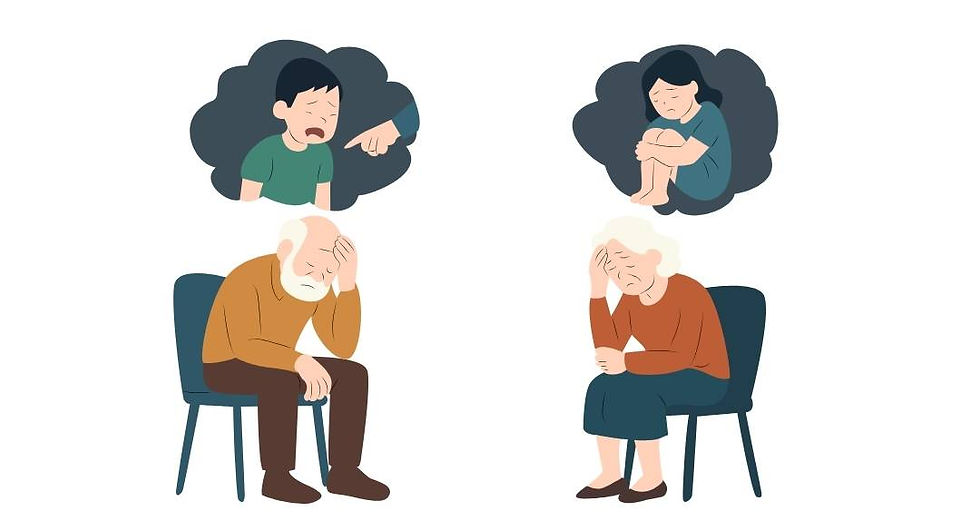How does EMDR Therapy Help With Anxiety?
- Dana Carretta-Stein, LMHC

- Mar 26, 2024
- 3 min read
Updated: Jun 12, 2024

Anxiety disorders are prevalent mental health concerns affecting millions of individuals worldwide. While various therapeutic modalities exist, Eye Movement Desensitization and Reprocessing (EMDR) has gained recognition for its effectiveness in alleviating anxiety symptoms. Developed in the late 1980s by psychologist Francine Shapiro, EMDR has evolved into a widely accepted and evidence-based psychotherapeutic approach.
What is EMDR Therapy?
EMDR therapy is rooted in the Adaptive Information Processing (AIP) model, which posits that disturbing memories contribute to psychological distress. Unlike traditional talk therapies, EMDR integrates bilateral stimulation through guided eye movements, tapping, or auditory cues to facilitate the processing of traumatic or distressing memories.
The EMDR 8 Phase Process:
Phases 1 & 2- History Taking and Treatment Planning:
The therapist conducts a comprehensive assessment to identify specific target memories causing anxiety. A treatment plan is then developed, outlining the memories to be addressed and the associated negative beliefs.
Phases 3 & 4- Assessment and Desensitization Phase:
During these phases, the individual identifies the event to reprocess and focuses on the target memory while engaging in bilateral stimulation. The therapist guides the client in reprocessing the memory, helping to alleviate the emotional distress associated with it.
Phase 5- Installation Phase:
Positive beliefs are reinforced to replace negative ones. This phase aims to enhance the individual's self-esteem and adaptive coping mechanisms.
Phase 6- Body Scan:
The therapist assists the individual in identifying and releasing any residual tension or physical discomfort associated with the targeted memory.
Phase 7 & 8- Closure & Reevaluation:
Each session concludes with a stabilization process, ensuring the individual feels grounded and equipped to manage any residual emotions that may arise.
With reevaluation, future targets and directions for continued treatment are determined
The Neurobiological Mechanisms of EMDR and Anxiety:
Research suggests that EMDR impacts the brain's neural networks, promoting adaptive information processing. The bilateral stimulation used in EMDR is believed to engage both hemispheres of the brain, facilitating the integration of traumatic memories into a more adaptive and less distressing form.
Empirical Evidence Supporting EMDR for Anxiety:
Numerous studies have demonstrated the efficacy of EMDR in treating anxiety disorders. A meta-analysis published in the Journal of Anxiety Disorders (2013) concluded that EMDR is as effective as cognitive-behavioral therapy (CBT) in treating anxiety, with some studies indicating superior outcomes for EMDR in certain cases.
Benefits of EMDR for Anxiety:
Rapid Results: EMDR often yields faster results compared to traditional therapeutic approaches. Many individuals report a significant reduction in anxiety symptoms after just a few sessions.
Versatility: EMDR is applicable to various anxiety disorders, including generalized anxiety disorder (GAD), social anxiety disorder, and post-traumatic stress disorder (PTSD).
Lasting Effects: Research suggests that the benefits of EMDR are often sustained over time, reducing the likelihood of symptom recurrence.
Eye Movement Desensitization and Reprocessing therapy stands out as a promising and effective approach for alleviating anxiety. Its unique methodology, combined with a growing body of empirical evidence, supports its application across a spectrum of anxiety disorders. As mental health professionals continue to explore innovative therapeutic modalities, EMDR emerges as a valuable tool in helping individuals overcome the debilitating grip of anxiety and reclaim their mental well-being
Briana Collins is a licensed mental health counselor (LMHC) at Peaceful Living Mental Health Counseling in Scarsdale, NY.
Briana specializes in working with teenagers and adults struggling with anxiety, life transitions, chronic pain & chronic illness, ADHD, and gender identity and PTSD.
Briana uses a combination of Acceptance Commitment Therapy (ACT), Eye Movement Desensitization and Reprocessing (EMDR Therapy), Dialectical Behavior Therapy (DBT), Cognitive Behavioral Therapy (CBT), Mindfulness, and Gestalt & Schema Therapy in her work with clients.





Anxiety disorders are among the most common mental health challenges, affecting millions of people worldwide and often impacting daily life, relationships, and overall well-being. At Good Health Psychiatric Services P.C., we understand the weight of these struggles, and our mission is simple: to be advocates for our patients’ mental health. Through compassionate, personalized care—including in-person sessions, group therapy, and telemedicine—our Big Five Personality Test expert Psychiatrists, Psychotherapists, and Nurse Practitioners work to educate, empower, and support each individual. From the very first contact with our caring staff to ongoing treatment, we are dedicated to guiding patients on their journey to recovery and helping them lead calmer, happier, and more fulfilling lives.